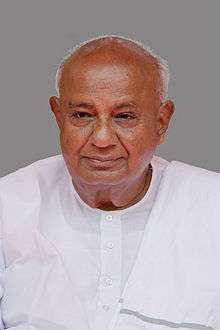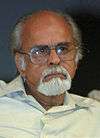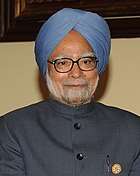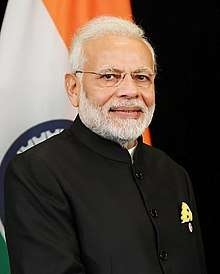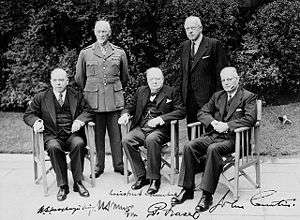List of prime ministers of India
The Prime Minister of India is the chief executive of the Government of India. In India's parliamentary system, the Constitution names the President as head of state de jure, but his or her de facto executive powers are vested in the prime minister and their Council of Ministers. Appointed and sworn-in by the President, the prime minister is usually the leader of the party or alliance that has a majority in the Lok Sabha, the lower house of Parliament of India.[1]
 |
|---|
| This article is part of a series on the politics and government of India |
|
National coalitions
|
|
|
Since 1947 India has had 14 prime ministers, 15 including Gulzarilal Nanda who twice acted in the role of which 6 having at least one full term, ruling country for about 60 years.[2] The first was Jawaharlal Nehru of the Indian National Congress party, who was sworn in on 15 August 1947, when India gained independence from the British Raj.[3] Serving until his death in May 1964, Nehru remains India's longest-serving prime minister. He was succeeded by fellow Congressman Lal Bahadur Shastri, whose 1 year 7-month term also ended in death.[4] Indira Gandhi, Nehru's daughter, succeeded Shastri in 1966 to become the country's first woman prime minister.[5] Eleven years later, she was voted out of power in favour of the Janata Party, whose leader Morarji Desai became the first non-Congress prime minister.[6] After he resigned in 1979, his former deputy Charan Singh briefly held office until Indira Gandhi was voted back six months later.[7] Her second stint as prime minister ended five years later on 31 October 1984, when she was assassinated by her own bodyguards.[5] Her son Rajiv Gandhi was then sworn in as India's youngest premier and the third from his family. Members of Nehru–Gandhi family have been prime minister for a total of 37 years and 303 days.[8]
Rajiv's five-year term ended with his former cabinet colleague, Vishwanath Pratap Singh of the Janata Dal, forming the year-long National Front coalition government in 1989. A seven-month interlude under prime minister Chandra Shekhar followed, after which the Congress party returned to power, forming the government under P. V. Narasimha Rao in June 1991.[9] Rao's five-year term was succeeded by four short-lived governments—Atal Bihari Vajpayee from the Bharatiya Janata Party (BJP) for 13 days in 1996, a year each under United Front prime ministers H. D. Deve Gowda and Inder Kumar Gujral, and Vajpayee again for 19 months in 1998–99.[9] After Vajpayee was sworn-in for the third time, in 1999, he managed to lead his National Democratic Alliance (NDA) government to a full five-year term, the first non-Congress alliance to do so.[10] Vajpayee was succeeded by Manmohan Singh, whose United Progressive Alliance government was in office for 10 years between 2004 and 2014.[11] The incumbent prime minister of India is Narendra Modi who has headed the BJP-led NDA government since 26 May 2014, is India's first non-Congress single party majority government.[12]
List of prime ministers of India
|
Timeline
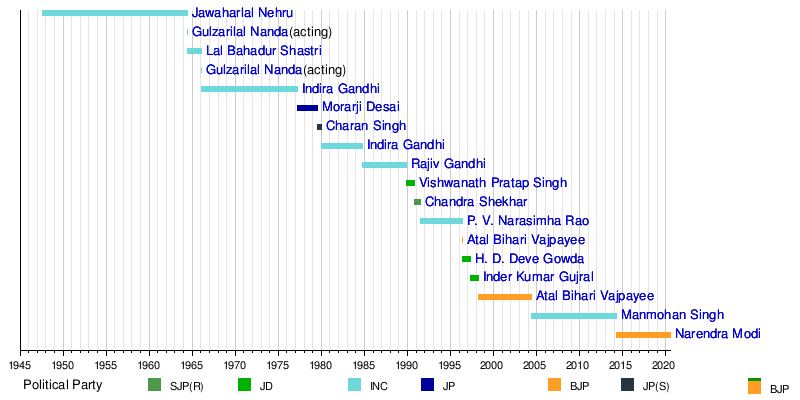
List of Prime ministers by length of tenure
| No. | Name | Party | Length of term | |
|---|---|---|---|---|
| Longest continuous term | Total years of premiership | |||
| 1 | Jawaharlal Nehru | INC | 16 years, 286 days | 16 years, 286 days |
| 2 | Indira Gandhi | INC/INC (I)/INC (R) | 11 years, 59 days | 15 years, 350 days |
| 3 | Manmohan Singh | INC | 10 years, 4 days | 10 years, 4 days |
| 4 | Atal Bihari Vajpayee | BJP | 6 years, 64 days | 6 years, 80 days |
| 5 | Narendra Modi | BJP | 6 years, 33 days | 6 years, 33 days |
| 6 | Rajiv Gandhi | INC (I) | 5 years, 32 days | 5 years, 32 days |
| 7 | P. V. Narasimha Rao | INC (I) | 4 years, 330 days | 4 years, 330 days |
| 8 | Morarji Desai | JP | 2 years, 126 days | 2 years, 126 days |
| 9 | Lal Bahadur Shastri | INC | 1 year, 216 days | 1 year, 216 days |
| 10 | Vishwanath Pratap Singh | JD | 343 days | 343 days |
| 11 | Inder Kumar Gujral | JD | 332 days | 332 days |
| 12 | H. D. Deve Gowda | JD | 324 days | 324 days |
| 13 | Chandra Shekhar | SJP (R) | 223 days | 223 days |
| 14 | Charan Singh | JP (S) | 170 days | 170 days |
Lists by party
Following is the summary of hold of Prime Minister's office by members of Indian political parties. The displayed data is as of 31 May 2020.
| No. | Political party | Number of Prime ministers | Total years of holding PMO |
|---|---|---|---|
| 1 | Indian National Congress/Indian National Congress (I)/Indian National Congress (R) | 6 | 54 years, 123 days |
| 2 | Bharatiya Janata Party | 2 | 12 years, 85 days |
| 3 | Janata Dal | 3 | 2 years, 269 days |
| 4 | Janata Party | 1 | 2 years, 126 days |
| 5 | Samajwadi Janata Party (Rashtriya) | 1 | 223 days |
| 6 | Janata Party (Secular) | 1 | 170 days |
- Parties by total duration (in years) of holding Prime Minister Office
Living former Prime ministers
As of 28 June 2020, there are two living former Prime ministers of India:
- Living former prime ministers
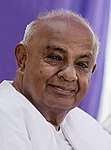
The most recent death of a former Prime Minister was that of Atal Bihari Vajpayee on 16 August 2018, aged 93.
See also
- Prime Minister's Office
- List of Prime Ministers of India by longevity
- List of Presidents of India
- Deputy Prime Minister of India
Notes
- In office
- Known as Indian National Congress (R) in 1969–1978 Indian National Congress (I) in 1978-96. [13]
- Gulzarilal Nanda twice appointed as acting Prime minister of India following deaths of two prime ministers.
- Although the Prime Minister can be a member of either house of the Parliament, they have to command the confidence of the Lok Sabha. Upon dissolution of the Lok Sabha, the outgoing PM remains in office until their successor is sworn in.
- The Constituent Assembly of India consisted of 389 members elected in 1946 by the provincial assemblies by a single, transferable-vote system of proportional representation. The Assembly was replaced by the Provisional Parliament of India after adoption of the Constitution on 26 January 1950 until the first general elections.
- Chandra Shekhar officially resigned as Prime Minister on 13 March 1991, but he and his ministers continued in office until Rao succeeded him.
Footnote
References
- Pylee, M.V. (2003). Constitutional Government in India. S. Chand Publishing. p. 252. ISBN 9788121922036. Archived from the original on 3 January 2018. Retrieved 2 January 2018.
- Mahurkar, Uday (15 May 1996). "At 98, two-time interim PM Gulzarilal Nanda is the epitome of Gandhian ideals". India Today. Retrieved 4 February 2019.
- Ramasheshan, Radhika (26 January 2012). "Why January 26: the history of the day". The Telegraph. Archived from the original on 17 November 2018. Retrieved 4 February 2019.
- Malhotra, Inder (15 January 1995). "Book review: Lal Bahadur Shastri Prime Minister of India 1964-66: A Life of Truth in Politics". India Today. Retrieved 4 February 2019.
- Vijaykumar, Neeti (19 January 2017). "Today in 1966: Indira Gandhi becomes Prime Minister". The Week. Archived from the original on 16 February 2018. Retrieved 4 February 2019.
- "Before Modi, there was Morarjibhai". Rediff.com. 7 April 2014. Archived from the original on 30 March 2018. Retrieved 4 February 2019.
- "JD-U demands Bharat Ratna to former PM Charan Singh". The Economic Times. 21 December 2015. Retrieved 4 February 2018.
- Denyer, Simon (2 December 2011). "In India, next generation of Gandhi dynasty". The Washington Post. Archived from the original on 28 December 2016. Retrieved 27 December 2016.
- Iype, George (3 May 2004). "What the former PMs are doing". Rediff.com. Archived from the original on 25 March 2010. Retrieved 4 February 2019.
- Ghosh, Deepshikha (16 August 2018). "Atal Bihari Vajpayee: The 3-Time PM Who Captivated India With His Oratory". NDTV. Archived from the original on 23 December 2018. Retrieved 4 February 2019.
- "PM Modi, Rahul Gandhi Greet Manmohan Singh On His 86th Birthday". Outlook. 26 September 2018. Archived from the original on 28 September 2018. Retrieved 4 February 2019.
- Panda, Ankit (16 May 2014). "BJP, Modi Win Landslide Victory in Indian Elections". The Diplomat. Archived from the original on 21 December 2016. Retrieved 27 December 2016.
- Statistical Report on General Elections, 1980 to the Seventh Lok Sabha (PDF). New Delhi: Election Commission of India. p. 1. Archived from the original (PDF) on 18 July 2014. Retrieved 20 May 2020.
- "Former Prime Ministers". PM India. Archived from the original on 9 October 2014. Retrieved 2 January 2015.

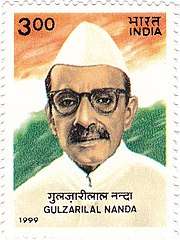

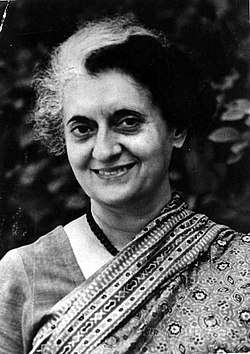
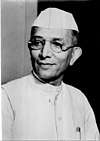

.jpg)
.jpg)

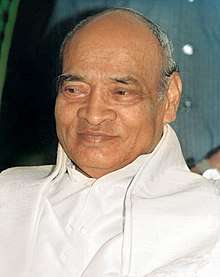
.jpg)
